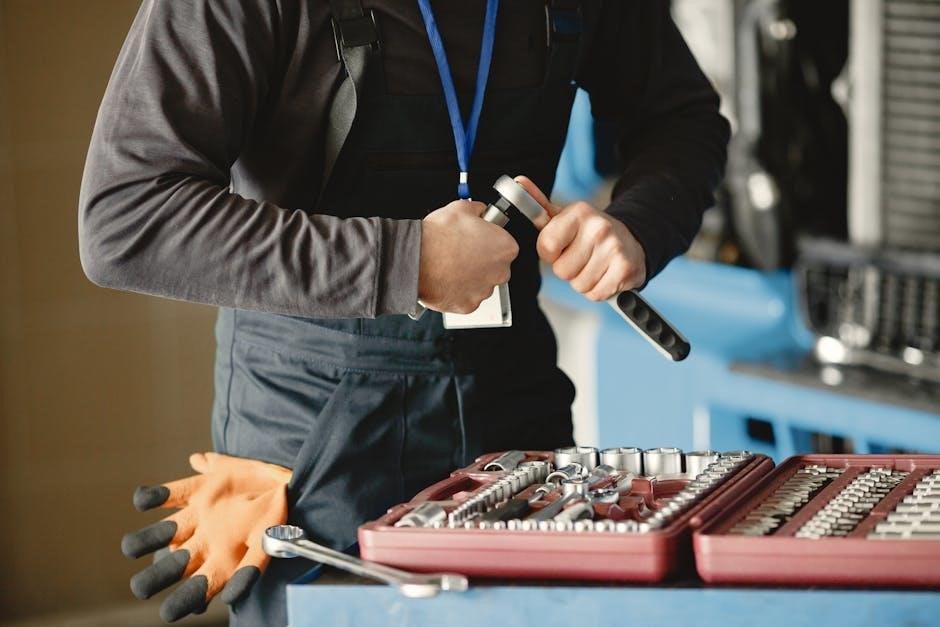The torque wrench user manual provides instructions on
proper usage
and maintenance for optimal performance and safety, including handling and storage guidelines to ensure longevity of the tool and its components effectively always.
Understanding the Importance of Torque Wrenches
Torque wrenches are essential tools for applying precise amounts of torque to bolts and nuts, preventing damage to threads and ensuring safety. The importance of torque wrenches lies in their ability to provide a controlled and accurate application of force, which is critical in various industries such as automotive, aerospace, and construction. Using a torque wrench helps to prevent over-tightening, which can lead to stripped threads, broken bolts, and other costly problems. Additionally, torque wrenches help to ensure that bolts and nuts are tightened to the correct specification, which is crucial for maintaining the structural integrity of buildings, bridges, and other critical infrastructure. By understanding the importance of torque wrenches, users can appreciate the need for proper usage, maintenance, and calibration to ensure optimal performance and safety. Overall, torque wrenches play a vital role in ensuring the quality and reliability of various products and structures, making them an indispensable tool in many industries. Proper use of torque wrenches can help prevent accidents and injuries.

Choosing the Right Torque Wrench
Selecting a torque wrench involves considering factors like drive type and size to ensure compatibility with existing tools and equipment always and effectively for various applications and tasks easily.
Measuring Thread Size for Proper Fit
To ensure a proper fit, measuring the thread size of the nut or bolt is crucial, and this can be done by using a ruler or measuring tape to measure the distance between two threads, which may require a magnifying glass for accuracy.
The size of the wrench refers to the size of the socket at the end, which is independent from the threading on the nut or bolt, and it is essential to check the threading on the inside of the nut or bolt to ensure compatibility.
The threading can be measured by counting the number of threads per inch or by using a thread gauge, and it is vital to select a wrench with the correct thread size to avoid damage or stripped threads.
Using the correct thread size ensures a secure and precise fit, allowing for accurate torque application and preventing damage to the surrounding material.
Proper measurement and selection of the thread size are critical steps in using a torque wrench effectively and safely, and it requires attention to detail and understanding of the threading system.
By following these steps, users can ensure a proper fit and achieve accurate and reliable results with their torque wrench.

Operating the Torque Wrench
Properly operating the torque wrench requires careful handling and technique always using the correct method and procedure for optimal results and safety every time with precise control and movement.
Setting the Torque Value and Tolerance
To set the torque value and tolerance, locate the torque measurements printed on the wrench, usually found on the main shaft. The horizontal hash marks indicate the different torque settings, allowing for precise control and adjustment. Enter the desired torque value and set the tolerance according to the specifications provided. It is essential to follow the manufacturer’s instructions for setting the torque value and tolerance to ensure accurate and reliable results. The torque wrench is designed to provide a precise amount of torque, and setting the correct value and tolerance is crucial for achieving the desired outcome. By following the proper procedure for setting the torque value and tolerance, users can ensure that their torque wrench is functioning correctly and providing accurate results. The process of setting the torque value and tolerance may vary depending on the type of torque wrench being used, so it is essential to consult the user manual for specific instructions.

Maintenance and Calibration
Regular maintenance and calibration of the torque wrench is necessary for optimal performance and accuracy, ensuring reliable results and extending the tool’s lifespan effectively always with proper handling techniques.
Pre-Tightening and Handling Techniques
To ensure proper use of the torque wrench, pre-tightening and handling techniques are crucial. The user should start by loosening the knob on the wrench until the handle spins easily, without removing it. This allows for smooth operation and helps prevent damage to the tool. When pre-tightening, it is recommended to use an ordinary Allen key to delicately tighten the bolt, saving a lot of turns with the torque wrench. The bit should be inserted inside the socket of the bolt head, and the extender should be grasped with the weaker hand, while the handle of the torque wrench is held with the stronger hand. Proper handling techniques also involve keeping the torque wrench clean and dry, and storing it in a protective case when not in use. By following these techniques, users can ensure accurate and reliable results, and extend the lifespan of the torque wrench. Regular practice and familiarity with the tool’s parts and functions are also essential for effective handling and pre-tightening.
Torque Wrench Components and Functions
The tool has several key
parts
including the shaft and extender release button for functional operation always.
Understanding the Tool Parts and Their Uses
The torque wrench is composed of several key components, including the handle, shaft, and socket. The handle is the main grip of the tool, allowing users to apply torque to the bolt or nut. The shaft is the long, cylindrical part of the wrench that connects the handle to the socket. The socket is the part of the wrench that fits onto the bolt or nut, and is typically available in a variety of sizes to accommodate different types of fasteners; Understanding the functions of these parts is essential for proper use of the torque wrench. The extender release button is another important component, allowing users to easily attach and detach the socket from the shaft. Additionally, the rotation direction switch allows users to switch between clockwise and counterclockwise rotation, making it easy to tighten or loosen bolts and nuts. By familiarizing themselves with these parts and their uses, users can ensure safe and effective operation of the torque wrench. The tool parts work together to provide a precise and controlled amount of torque, making it an essential tool for many industries and applications.

Troubleshooting Common Issues
When using a torque wrench, users may encounter various issues that can affect its performance and accuracy. One common problem is inaccurate torque readings, which can be caused by improper calibration or worn-out components. To troubleshoot this issue, users should refer to the user manual and follow the calibration procedure. Another common issue is the torque wrench slipping or failing to tighten the bolt or nut properly. This can be due to incorrect socket size or insufficient grip on the bolt or nut. Users should ensure that the socket is properly seated and that the torque wrench is held firmly in place. By identifying and addressing these common issues, users can ensure that their torque wrench is functioning correctly and providing accurate torque readings. Regular maintenance and inspection of the torque wrench can also help prevent issues from arising. The user manual provides guidance on troubleshooting and maintenance to help users resolve common problems and extend the life of their torque wrench. Proper care and attention can help prevent issues and ensure reliable operation.